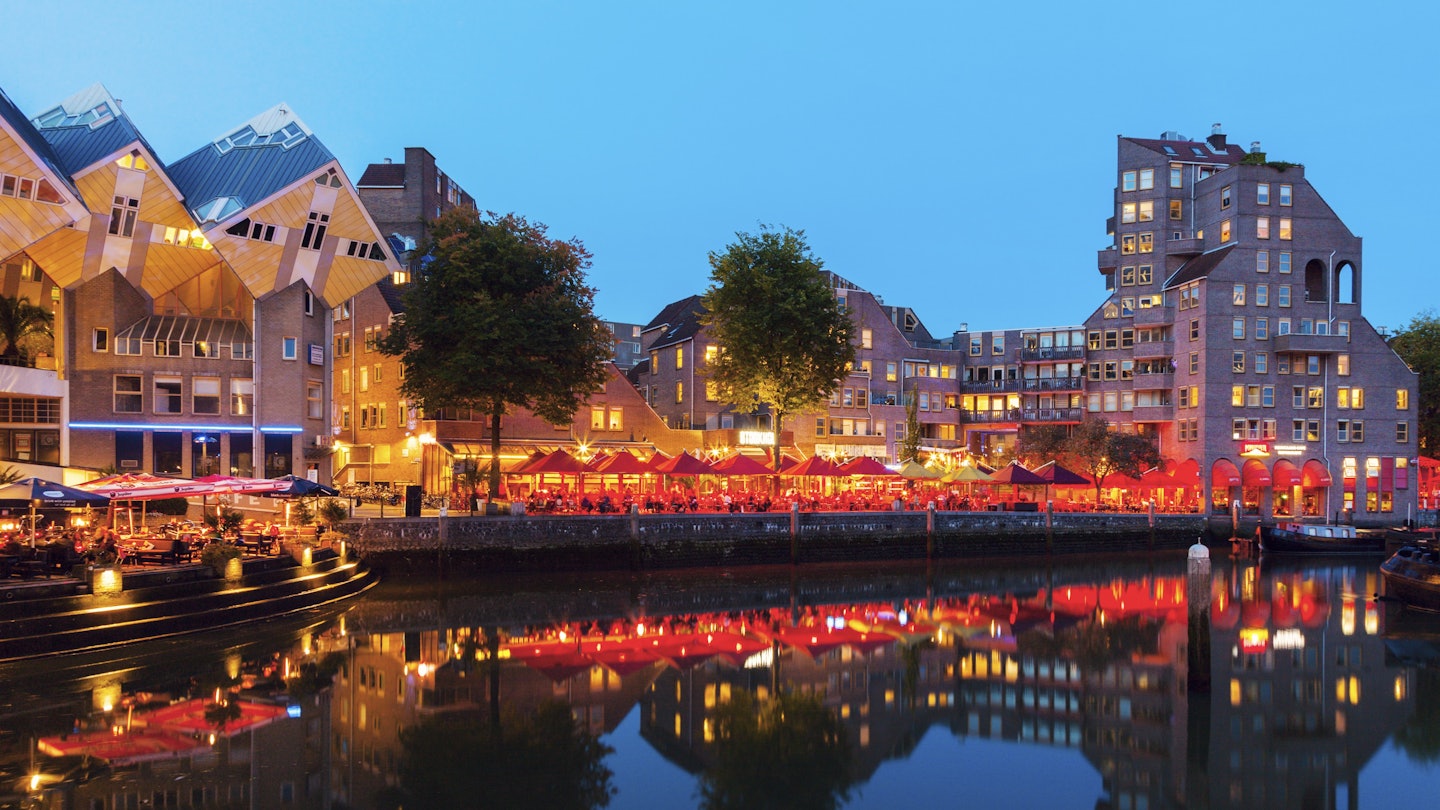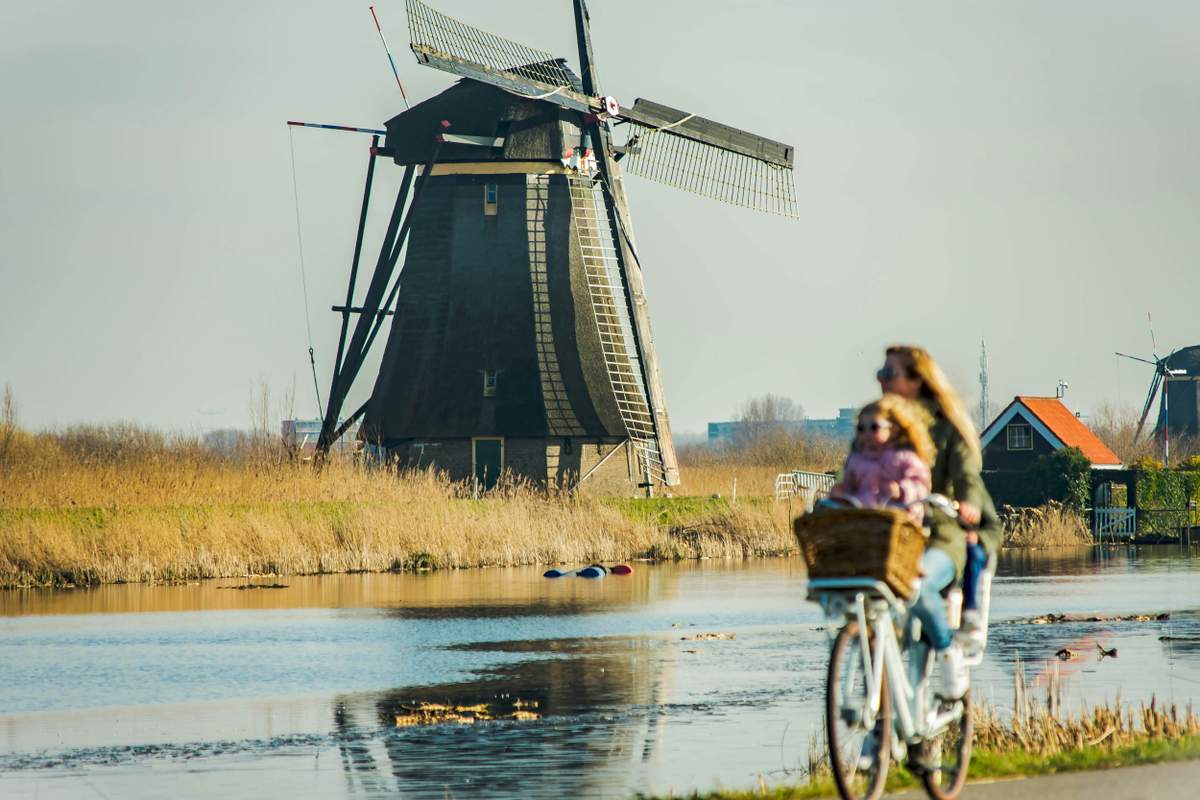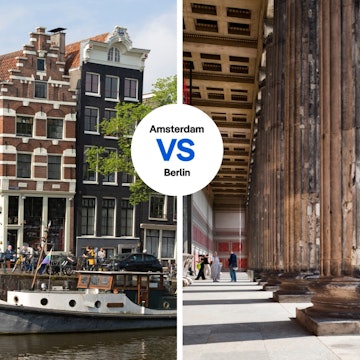

The waterfront in Rotterdam. Henryk Sadura/Getty Images
Rotterdam, the Netherlands’ trendy port city, is one of Europe’s most fabulous spots. Innovative architecture, larger-than-life urban art installations, and eclectic museums and businesses make for an exciting visit. Compared to Amsterdam, the more laid-back and less touristy urban vibe makes the Dutch second city a favorite for many.
The city’s downtown streets, where you’ll find a great deal of attractions, are easy to cover on foot, and are well-connected to other neighborhoods by public transport, such as tram and watertaxi. Make the most of your time in Rotterdam with our guide to the best things to do.
1. Grab food at the Markthal
As the visual heart of this city, the Markthal is a beloved and bustling place. Opened in 2014, it's one of the city's favorite foodie hubs hosting a variety of fast-food stands and eateries spanning global cuisine. Beyond a bite, the architecture itself is worth checking out – the innovative design, a striking U-shaped arc, inverts a "traditionally Dutch" market hall, putting it on top of offices and residences framed by floor-to-ceiling glass. A massive ceiling mural by Dutch artists Arno Coenen and Iris Roskam, flaunting a colorful cornucopia of food, flowers and insects, references 17th-century Dutch still life paintings.

2. See the cube houses (and stay in one!)
Perched high above the roads and intricately intertwined, Rotterdam's legendary row of cube houses, tilted at a unique 55-degree angle, never fails to captivate passersby departing from the city center's Blaak Train Station.
In the 1970s, city planners faced the challenge of uniting residence blocks across Blaak St. The ingenious architectural solution was cubic homes. The Overblaak (Black Woods) Development comprises 38 vibrantly colored, crazily tilting residences and two "super-cubes" on hexagonal pylons. Inspired to be an urban forest, some sit atop a pedestrian bridge (the Luchtsingel) from which you can get sprawling views over the cubed houses against downtown.
Planning tip: All cubes are privately owned. One apartment, the Kijk-Kubus Museumwoning (Cube House Museum), is a staged apartment you can visit. The southernmost cube is the Stayokay Rotterdam youth hostel where you can sleep in a dorm with awesome harbor views.
3. Grab a watertaxi
Jumping aboard a watertaxi is a truly Rotterdam experience. With 50 ports along the Maas river circumventing the city, they play an integral role in helping locals get around the city. They’re also great for sightseeing, docking at several important landmarks including Erasmusbrug (the Swan), the Hotel New York and Maritiem Museum.

4. Go behind the scenes at Depot Boijmans Van Beuningen
The Museum Boijmans van Beuningen, one of the Netherlands' most famous art institutions, has a staggering treasure trove of some 150,000 masterpieces, but, due to spatial constraints, the majority have been hidden from the public.
While the museum is engrossed in a massive renovation expected to end in 2029, visitors are privy to a different immersive experience: the museum's Depot Boijmans Van Beuningen, the world's first open-access art storage facility. Behind unlocked compartment doors check out a rare temporary museum where priceless works, usually on loan elsewhere, are displayed.
5. Feast on Tante Nel’s famous friet
Ask any Rotterdammer about their favorite fast food and the answer will likely be Tante Nel’s friet. Serving the local version of French fries from its hybrid snack shack and bar in Centrum, Aunt Nel serves friet that are hand-cut and expertly fried, best eaten with met (mayonnaise) or stoofviees (a rich meat stew). The bitterballen (Dutch meatballs) are pretty good, too.
6. Marvel at the modernist Van Nelle Fabriek
One of only 11 World Heritage–listed cultural sights in the Netherlands, this concrete, steel and glass factory is a modernist masterpiece with a fascinating history. Van Nelle opened in 1931 as an "ideal factory" of the future, humanizing industrial labour (coffee, tea and tobacco production) through innovative architecture. Its unique social vision was aimed at boosting workers’ welfare, and therefore productivity, through features such as modular, well-lit spaces and gender-segregated areas.
Planning tip: Today, the building mostly houses creative agencies, but you can discover Van Nelle’s architectural history on a guided tour.

7. Enjoy a tipple at a local microbrewery
When it comes to beer, Rotterdammers clearly believe that small producers are best. Microbreweries are scattered throughout the city, with popular venues including Brouwerij Noordt and Stadsbrouwerij De Pelgrim in historic Delfshaven. South of Centrum, in Katendrecht (a former red-light district), the popular Fenix Food Factory is home to artisanal food and drink stalls including the Kaapse Brouwers taproom. At this hipster outfit, sip more than 20 craft beers produced right on Rotterdam soil.
8. Learn about wartime Rotterdam at Museum Rotterdam '40–'45 NU
Few cities were as disastrously impacted by WWII as Rotterdam. In a bunker-like building beneath a bridge, this small but excellent museum documents city life through old photographers and other artefacts. The immersive multimedia experience outlines the terror and destruction that was caused during the Rotterdam Blitz (on May 14, 1940, when 54 German aircraft dropped 1300 bombs over a 13-minute period, killing more than 900 people).
Other exhibits highlight the Nazis' unconscionable treatment of Rotterdam’s Jewish community under the occupation, the valiant contribution of local resistance fighters and the joyous liberation of the city by Canadian troops on May 8, 1945.
9. Enjoy a gin in historic Schiedam
Back in Holland’s Golden Age, Schiedam was known for its jenever, a spirit that's considered the forerunner of gin. Popularized by Dutch East India Company training, and 17th-century soldiers who drank it for "Dutch courage", try the heady tipple and learn its history at the Nationaal Jenevermuseum in the neighborhood’s distillery district.

10. Stroll the historic streets of Delfshaven
Be sure to wander along the pretty-as-a-picture streets and canals in Delfshaven, Rotterdam’s gorgeous Golden Age relic (and one of the few neighborhoods to be spared in the 1940 bombings). While here, pop in for a drink at one of its famous bruin cafés (traditional Dutch pubs) and gaze up at one of the Netherlands’ largest windmills.
11. Scour the city for Kunst en Vaarwerk’s pop art
From 1979 to 1992, postwar Rotterdam’s hasty concrete constructions were given a creative boost by the Dutch-pop artists’ Kunst en Vaarwerk. You can find all the group’s larger-than-life art installations and sculptures, integrated onto preexisting buildings, on Rotterdam's BKOR (Visual Arts & Public Space) foundation website.
Most well known is the gravity-defying Red BMW, a vehicle protruding out of the glass facade of 169 Weena, and one of the concrete columns beneath the Zuidplein metro station transformed to look like a rolled-up newspaper.
Planning tip: BKOR has a zoomable map so you can create a self-guided walking tour for yourself.
12. Join the party on Witt de Withstraat
If there’s one art the locals have perfected, it’s outdoor eating and drinking. In fine weather the cafes, bars and eateries along Witt de Withstraat unfurl the street umbrellas over their street furniture, crank up their sound systems and welcome boisterous groups of Rotterdammers young and old.
If you join them, you’ll probably find yourself cheek-by-jowl with backpackers from nearby hostels, staff from the cultural institutions in Museumpark, office and retail workers from Centrum and those from other neighborhoods who know that this is where the best party in town takes place – every night into the wee hours.
Planning tip: Our favourite watering holes include De Witt Aap at number 78 and Wunderbar, which is located just around the corner at Boomgaardsstraat 71.

13. Take a day trip to Kinderdijk
Despite much to see and do in Rotterdam, Kinderdijk is a day trip out of the city worth taking. The almost impossibly picturesque World Heritage Site landscape of marshes, canals and historic windmills is a quintessentially Dutch traditional landscape. It’s best explored by bicycle – hire one in Rotterdam and then take it onto the number 202 waterbus ferry from the Erasmusbrug ferry terminal.
After a 30-minute journey, hop onto your bike and follow the dual pedestrian and cycle path between the canals, stopping to visit 17th-century windmills-turned-museums as well as the visitor centre in a 19th-century pumping station. In summer, tall reeds line the canals, lily pads float on the water and bird calls break the silence – it’s truly charming.
14. Go for a walk along Hofbogen
A cleverly repurposed old railway viaduct, the 1.9km-long (1.2-mile) Hofbogen is an "ecological corridor" housing boutiques, cafes, ateliers and other creative spaces under the viaduct's concrete arches. Along the Netherlands' longest, narrowest roof park, go for a literal walk in a lush sky garden and enjoy the fresh air.
15. Relax on the Schieblock rooftop
A late-1950s office building now housing sustainably focused design studios, the Schieblock is one of Rotterdam’s breeziest hangouts thanks to its harvestable roof cafe. Catch panoramic views from Op Het Dak over the train tracks while munching on seasonal, local fare sourced from the rooftop garden.

16. Admire the majestic De Rotterdam building
The city's most acclaimed contemporary building is easily De Rotterdam. In a city replete with architectural masterworks, the interconnected stack of glass and steel boxes forming the complex stands out for its audacity and size. Designed by local firm OMA, which is headed by Rotterdam "starchitect" Rem Koolhaas, this vertical city is the visual linchpin of revitalized former port area Kop van Zuid.
Planning tip: At sunset, when De Rotterdam’s lights first turn on, the building’s colossal facade is truly a wonderful sight. For the opposite perspective, head to the building’s seventh-floor nhow Hotel cocktail bar for a panoramic sweep of the Erasmusbrug and Rotterdam’s skyline.
17. Catch a live jazz performance
Many consider Rotterdam to be Europe’s de facto capital of jazz. The best time to catch jazz fever is in July during the annual North Sea Jazz Festival when performances take place across open-air spaces and more intimate venues. Outside of that, live music of all genres is a big part of Rotterdam’s vibrant culture and nightlife scene.
Planning tip: Catch a jazz gig at local institutions such as Jazzcafé Dizzy and Bird Jazz Club.















